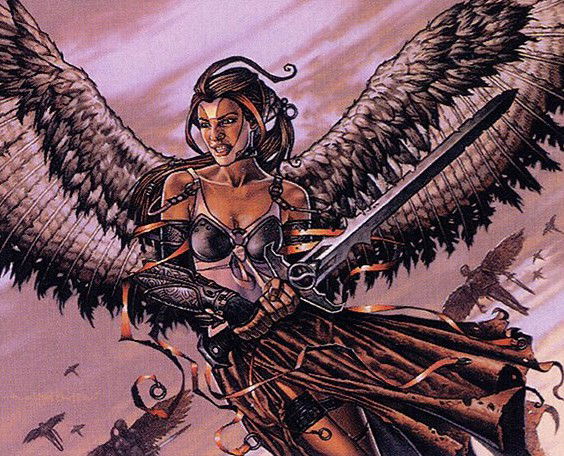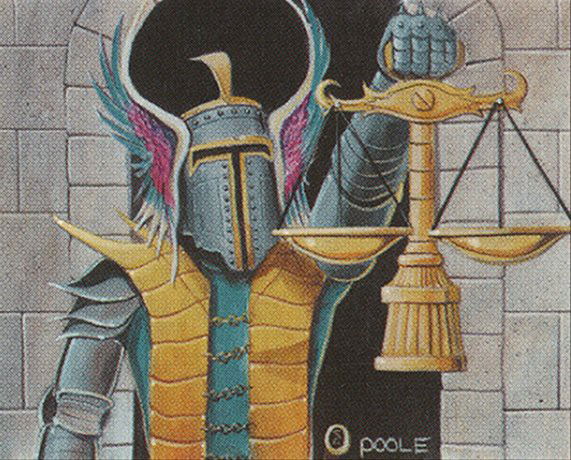
Hello, I'm João Manoel Queiróz, known as "Paredeebranca" at MTGO and Arena. I've been a Magic: The Gathering player since the Khans of Tarkir block in 2014.
Despite the short time I've been playing, I'm an enthusiast and passionate about old frame cards – one of my collections – and I found a format that fit perfectly in this context: Premodern.
What is Premodern?
Premodern is a format not just for the most nostalgic Magic: The Gathering players, but for everyone.
Ad
In addition to the feeling of nostalgia, Premodern draws attention for using old frame cards (reprints are legal), including cards from World Championship Decks. Alongside the defined sets, the format also features a banned card list, totaling 32 cards.
It is a non-sanctioned format that emerged in 2012, being the brainchild of Martin Berlin. It has cards from the 4th Edition (1995) to the Scourge (2003) — except for the non-regular sets Portal (1997), Portal Second Age (1998) and Portal Three Kingdoms (1999) — a moment that precedes the change of frame that took place in 8th Edition, in 2003.
Initially, Premodern appears to be a cheaper option compared to Vintage and Legacy, but, like every format, it has cards with a higher value, such as Onslaught's fetch lands, but also with accessible options on the pain lands from Ice Age (1995) and Apocalypse (2001).
Non-Rotating
Another interesting factor of Premodern is the non-rotation, being an eternal format the fear of new bans is very low, which encourages players to purchase the cards.
One more facet of our beloved format, as mentioned a little above, is the usability of World Championship Decks, which have some cards with more affordable value, such as Survival of the Fittest and Recurring Nightmare.
Old Cards
What also proves to be something very dynamic is the search for old cards — the digging in the people's bulks — that until recently were forgotten and left in the shoeboxes, now they can contain great cards for different decks , which moves the circle of cards and negotiations between players and the sale of old frame cards in stores. In the end, everyone wins: the players, the stores and the format.
For old frame card collectors like me, the format is comforting — I've always wanted to use my Lin Sivvi, Defiant Hero to tutor rebel cards from Mercadia Masques (1999).
After this little presentation of the format, let's talk more about the legal sets, the banlist and some decks.
Legality
There are 29 legal sets in total, 4 core sets, 1 pseudo-expansion reprints — Chronicles that was released in 1995 between Ice Age and Homelands, re-released cards from Arabian Nights, Antiquities, Legends, and The Dark — and 24 block expansions of Ice Age, Mirage, Tempest, Urza, Mercadia Masques, Invasion, Odyssey, and Onslaught.
Sets: 4th Edition, Ice Age, Chronicles, Homelands, Alliances, Mirage, Visions, 5th Edition, Weatherlight, Tempest, Stronghold, Exodus, Urza's Saga, Urza's Legacy, Classic 6th Edition, Urza's Destiny, Mercadia Masques, Nemesis, Prophecy, Invasion, Planeshift, Seventh Edition, Apocalypse, Odyssey, Torment, Judgment, Onslaught, Legions, Scourge.
Banlist

Let's talk more about Premodern's ban list, below I list the 32 cards banned from the format:

Ad
The banlist is very specific, containing some cards from the Reserved List, like Yawgmoth's Will, also banned in Legacy and restricted in Vintage, and some other cards banned in other formats like Balance, banned in Vintage and Duel Commander.
It is also worth mentioning the presence of Memory Jar, legal only in Vintage and Commander.
Metagame
Tier Decks
To dwell on the Premodern Metagame, we will base ourselves on the North American Premodern Championship, a championship that took place on May 15, 2022, with 111 players.
Angry Hermit
The great champion deck was Flint Espil's Angry Hermit, which tries to put Phyrexian Dreadnought in play as quickly as possible, especially thanks to Stifle.
Jeskai Control
The Solution, Jeskai Control, deck chosen by Brian Kowal, is another strong deck that also made the top 8 in the North American championship.
Exalted Angel is always strong, regardless of the deck, especially with the company of Mother of Runes. Lightning Angel is also another creature that puts pressure on the board, with its 3/4 body with flying, vigilance, and haste.
Sligh (Burn)
Still in the top 8 of the North American championship we have a Sligh, name that Burn receives in Premodern, a deck that is present in practically all formats, here, piloted by Aaron.
As usual, the Sligh is always very fast and if it comes with a very consistent hand, hot wins the game in a few turns, especially when you sequence your early plays alongside a Ball Lightning
It's a great deck for anyone looking to get started in the format.
Most Popular Decks
In addition to the three decks already mentioned, it is impossible not to comment on some famous Premodern lists:
The Rock
An essentially black and green Toolbox style deck that has as its main piece one of the main format staples: Survival of the Fittest, a card from the Reserved List that tutors for hand any creature card from the deck by paying one green mana and discarding a creature.
The Rock also uses some cards with ETB, like Deranged Hermit which creates Squirrel tokens that you can feed for Recurring Nightmare.
Simic Madness
It's a budget-friendly and aggressive deck whose main theme is Madness. The blue color of the deck includes some counterspells like Daze, Circular Logic and green offers creatures like Wild Mongrel, Basking Rootwalla and Arrogant Wurm !
Azorius Landstill
A famous control deck that generates a lot of Card Advantage, as Standstill, the star of the deck, punishes the opponent since drawing 3 cards helps to find the correct answers.
The deck features Manlands and Decree of Justice as very effective finishers.
Elves
Elves is a very synergistic and consistent deck that exists in many formats, and Premodern would be no different.
In the more traditional lists, the lords, Eladamri, Lord of Leaves and Elvish Champion, are strong pieces, as they increase the power of the other elves, making all of your small threats into huge beat sticks.
Ad
But we also found some more Toolbox-style lists that run Survival of the Fittest. As an example, we'll stick with a more traditional list.
Dimir Psychatog
The last deck that I bring in this article is the famous Dimir Psychatog. In 2002, Carlos "Jabaiano" Romão was world champion with a list that used Psychatog as the main creature and a huge array of removals and counterspells.
Premodern's Dimir Psychatog lists are based directly from the champion deck in 2002.
The focus is on keeping Psychatog on the battlefield and use its ability to attempt a lethal attack while disrupting your opponents.
Staples
Taking a more general view of Premodern, we could find some cards of all types, considered Staples in the format, for different reasons and abilities — creatures, enchantments, artifacts, lands, instants, and spells — used in different decks and archetypes :
Creatures

Enchantments

Artifacts

Lands

Instants

Sorceries

Conclusion
So, after the topics of this introductory article, I hope I've brought a bit of Premodern to everyone. It's a format that has been gaining ground in several countries and that still has a lot to offer, as the possibilities for decks and strategies are vast.
Some sites host many Premodern decks, which helps players discover new lists and create their own, and this is when imagination knows no bounds: the options are huge, from decks such as clerics, saprolings, goblins, elves and zombies, to reactive decks like the Azorius Control, going through the Midrange archetype with the well-known The Rock.
Something that can be great is to look up some lists of the most recent championships and see what can be changed, making the deck closer to your taste with the strategies you like the most.
I hope you like my first article.
See you next time!








— Comments0
Be the first to comment